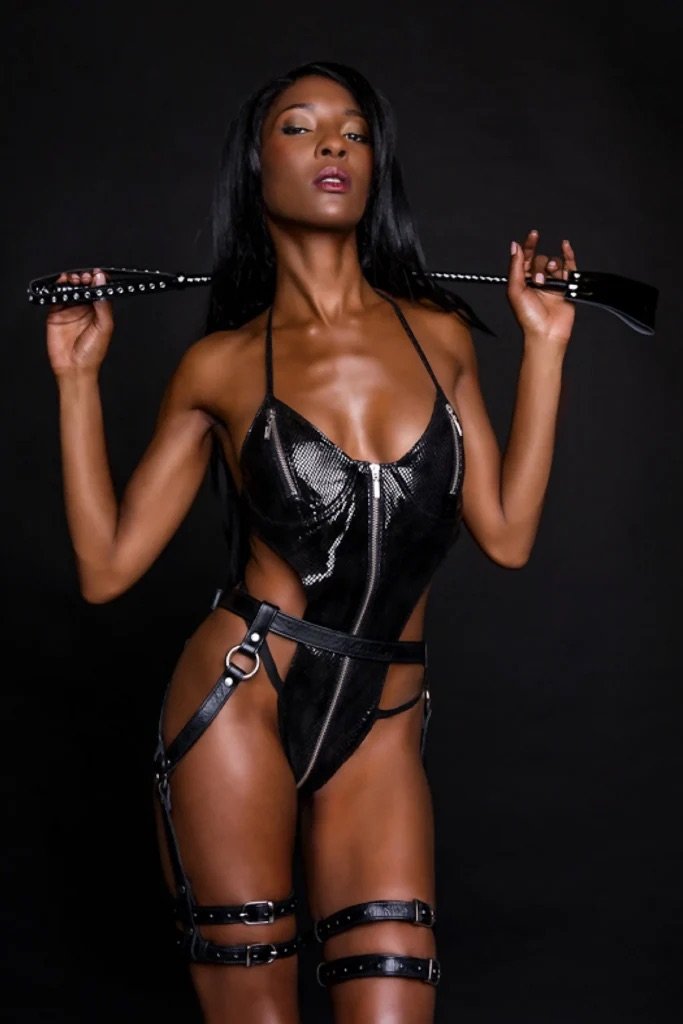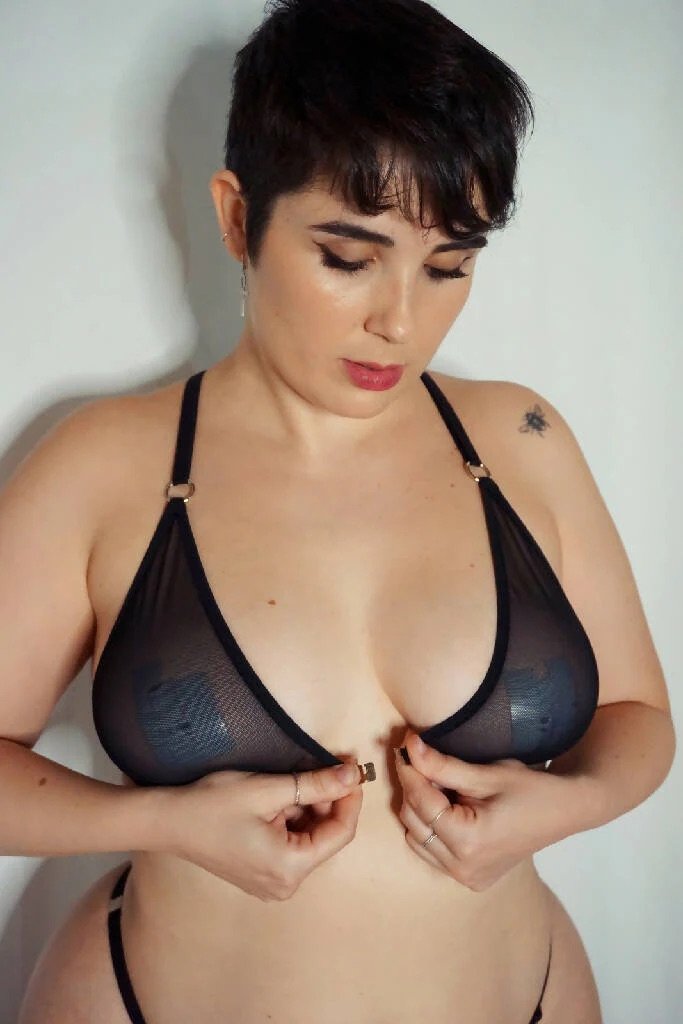From Clothes Swapping to Kink Couture: The Journey of Wasted Chic and Charmskool
Clothes swapping, supporting independent brands, colourful latex and expanding the kink clothing world – just a few of the topics we got stuck into when we met Alexandra and talked through her story as the ambitious founder of Wasted Chic and Charmskool.
Daisy: To kick things off, could you explain in your own words what Wasted Chic is and how you got started?
Alexandra: Well, Wasted Chic is an umbrella company for lots of different projects. The root was a pop-up event that I had the idea for when I was an Executive Assistant at Microsoft, I spent a lot of my work day alone and the idea came to me – this was back in 2013 or 2014, so the pop-up concept was still pretty new. You didn’t shop via Instagram, Facebook, or Depop, so I was spending my time on Etsy and hosting clothes swap parties at my house. What was originally a wardrobe clear out via swapping became people thinking ‘Oh can I sell my handmade hats? Can I sell this and that?’ The events just outgrew my house, so I booked a venue and took the plunge.
Daisy: And how did that first pop-up go?
Alexandra: The first event had 15 sellers at it, which in hindsight is a decent number. It was a mixture of friends from my swap parties and I also reached out to some vendors. It was a pretty simple formula – get people together and let them shop IRL.
I think it provided something people were missing, at that time you didn’t have funky little boutiques around London like you used to. Lots of the more interesting, independent retail stores were closing because of the business rates and rents increasing, so shopping felt very ‘chain-ified’. But here you could meet the sellers, or meet other business owners, see where products were coming from, touch them, feel them, try them on, and really know what you were getting in a way you just can’t online.
Daisy: So that was the first Wasted Chic pop-up, and how did you get started with Charmskool and Le Boutique Bazaar?
Alexandra: Well, I was starting to get into the kink scene myself, and thought there were just so many amazing fetish designers out there, the Wasted Chic format would work so well for a fetish-style event.
There were other alternative markets that I've been to, but they were very old school, and not super creative. I knew there were more expansive options out there because I had seen what people were wearing at the Torture Garden. So we started Le Boutique Bazaar later that year (2014) and we’re about to celebrate our 10th anniversary in autumn!
It did take time to build up though, there were definitely some events where I’d be hiding in the bathroom thinking ‘Where is everybody?!’ We came of age during the pandemic, I was keeping the Instagram account alive and whilst people were at home they were discovering us, our first event back post-COVID had 700 people in attendance!
As for Charmskool, since about 2009 I wanted to build an online marketplace for kink items, but there wasn’t a way to build it at that time – aside from paying developers a hefty amount to create it from scratch.
All the while I was working corporate jobs, and for other marketplaces gaining a lot of skills and seeing their inner workings. I ended up being made redundant and decided that was the time. There were new options for the technology we needed (I don’t want to give away my secrets!). It was still very clunky, but Boutique Bazaar was a market in London four times a year, it wasn’t accessible to people to people who couldn’t be here for those dates.
Charmskool brings the best from our Le Boutique Bazaar events together, but also hosts other international makers, other platforms like Etsy, have become so saturated in mass-produced rubbish, so every seller that joins Charmskool is audited and approved by me.
Again, it’s been quite a slow build, I spend a lot of time reminding people that we now have this incredible emporium of awesome fetish stuff and fetish-related products, curated, and made independently, you can unlearn the trawling through Instagram or Amazon and come here.
Daisy: I love that. There are so many benefits to shopping from smaller brands in this way, what do you think is the best motivator to try it?
Alexandra: I think a lot of people really, truly do want to shop sustainably, but maybe something like Etsy is overwhelming. You don't know anymore who's just bought it in from China and faked it, or who is selling genuine items- which is a shame because Etsy used to be great.
I also think people do want to have a connection with the brands they shop, to feel like they can reach out and ask a question, change their mind about the colour, you know, and that they know that they're buying from a small seller and also from a small business that looks after small sellers.
I think people just generally want to do that, it's just sometimes they don't know where to start. So hopefully we can make that a little easier.
Daisy: You’re right. I’ve heard a lot from people who want to start shopping vintage that shops are just too overwhelming and it puts them off, I think your curation makes it a lot less daunting.
Alexandra: There’s a limited amount of time I can spend on merchandising and marketing but when I can I love to help with style edits too, like ‘Hey, you're going to Burning Man, like here's our best outfits for it’. One guide we have created that's very popular is our masculine section because we found that masculine people struggle to find cool stuff to wear. A lot of the time their option is just a basic harness from Amazon, so we’re policing that category to make sure it’s full of cool things, shot on masculine bodies. Ensuring that masculine people have a choice of things that look interesting, high quality, and not too feminine for their style.
Daisy: I have to ask a fun question now in light of this styling conversation – what do you personally like to wear and why?
Alexandra: I'm known for my very colourful outfits. I've always worn colourful latex and stuff even since I started going to parties back in the day. I think it's because a lot of people in the scene had come from a goth-kind of background, whereas I was a raver, so all my outfits give 90s club kids and are super colourful. I love to also mix in unexpected accessories, I always wear huge accessories and a massive wig!
I just wrote an X post about being a dominatrix and feeling obligated to wear black-, wearing black doesn’t make you dominant, wearing a bold colour and making everybody’s head turn when you walk in the room – that’s dominance for me. You should wear whatever you feel amazing in and I hate the idea that fetish stuff has to be black. Why? Who decided that?
Daisy: I completely agree, I don’t know why people want to be so uniform when they could be more eye-catching. What else have you learnt from this world, and from setting up your businesses?
Alexandra: Well, I can’t believe I’m here! I have really bad ADHD, actually, I had to be taken to Yale University Hospital to be diagnosed when I was 7. Also, I've got dyslexia but with numbers, it's just called dyscalculia, so numbers are not only sometimes reversed, they're a very abstract concept to me overall.
With everything I've set out to do, I've had to just figure out how to do it.
I don't work well within other people's frameworks, which is why I've been through a million jobs. Sometimes when something doesn’t work out at a job you immediately think, ‘Oh, it's me, I've done a bad job’, but working for myself I’ve learnt I just have to make things simple for myself. Sometimes when I look back to where I started and how I now manage multiple projects, with hundreds of sellers, I’ve had to learn so much from the backend of web development to letting go of perfectionism. Every day is a school day.
I think a lesson to share would be to start with something easy and just put it out there.
I also think there's this concept that you have to be a martyr when you're an entrepreneur. Or that you have to work until your eyes are shutting and you can't go anywhere and do anything and you have to ruin your whole life. I refuse to subscribe to that. You have to do the things that make you feel stimulated and you have to find a way to do them that works within your budgetary and schedule restraints. That was a huge learning for me. The fashion industry is one of the worst for that kind of martyrdom, you don't need to do that. It's not productive.
Daisy: Both are such good lessons, for entrepreneurs and the people who work with them. My next question looks at the future, what’s coming for you?
Alexandra: Expansion!
I’m looking to get us out of the UK during this horrible cost of living crisis it’s affected a lot of small businesses, us included. The UK will always be the base of the business, but we need to focus on EU brands and customers, as well as the US and other markets that are healthier. This is a new area for me, expansion into a foreign territory, but I’ll work it out!
Daisy: So many lessons! Are there any final insights you would want to share for people ready to dip their toes into the kink world, instead of the business world?
Alexandra: For starters, there are a lot of online spaces you can find information on, a lot of events also have separate socials which are a great starting point to meet people. They’re a great way to sus out which crowd and event will suit you – some are very hard and heavy, some are just for women, and some are just for POC… there are always a lot of other newbies at socials that you can meet and you don’t have to go in a full fetish outfit.
The community is way more extensive than you think and there are niche parties for everything! I actually think the smaller parties are great and less expensive, and you leave feeling like you met some great people in more of a house-party setting. It’s much nicer.
_
Daisy Riley is a Fashion and Culture writer and researcher based in London. Working across journalism, brand strategy and content creation she writes to explore the possibilities and meanings hidden in what we wear, and how we can change the industry for the better.









